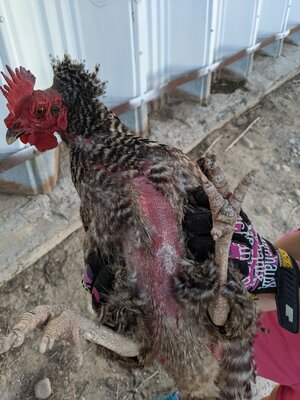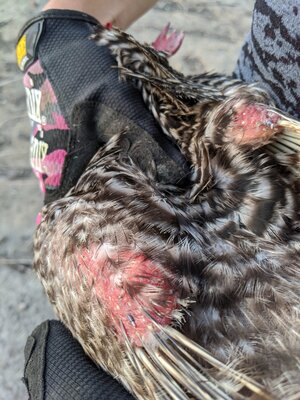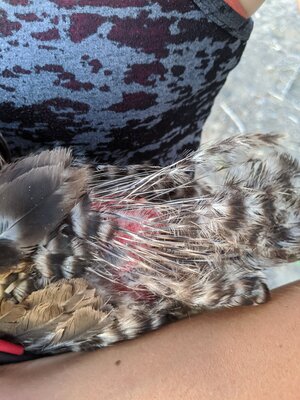I've been kicking myself for not getting around to writing this earlier. I'm going to try and keep this concise, but bear with me!
About 9 months ago (~October 2019) one of our chickens (Plymouth Barred Rock) started getting some "bald" spots on the back of her wings. I didn't pay much mind to it, thinking maybe she was going molt. She never did. It progressed, very slowly. I kind of figured that maybe she was rubbing up on something and losing her feathers this way. But it has slowly gotten worse and spread to other parts of her body. I really continued to push it off, she did not act sick and all my other chickens were good too.
Fast forward to the spring. She continues to have a "thining" of her feathers (the feathers are still there but they are "thinned"), and she has BALD spots. ALL over her body. They look terrible, bright red/pink. As far as I can tell, she is "top" chicken, she always has been, and she continues to remain this way despite looking so terrible. She continues to act healthy, is food motivated, friendly, active, and I believe* is still laying. I felt bad for her, but still didn't put much into it since all the other chickens were looking healthy/good still.
About a month and a half ago I noticed that another chicken (a year younger) had the same thing starting. In the exact same way, on the back of her wings- little balding spots. And another is now looking "splotchy" with her loss of feathers. My chickens have molted before. This is NOT a molt.
Ok. About a month ago, we had a really sick chicken that died. I think* this is completely unrelated, but I'm trying to paint a full picture. We got home after the weekend, she was lethargic, listless etc. Not doing well. We removed and quarantined her for a week before ultimately deciding to euthanize her; she did not get better but only continued to deteriorate. It was really sad for us, our first chicken loss. I don't believe that this was in any way related, I suspect an abdominal problem with her as her belly was very swollen.
As a result though, I immediately deep cleaned the coop (light bleach, removal of everything). I dusted for mites. I dusted the chickens 2x for mites (1 week apart). Although I'll admit, I really don't know if I "dusted" them correctly or not...how do you know? A few youtube videos I suppose.
I have been religious for weeks now with watering with apple cider vinegar water. I give them "treats" regularly with pumpkin, garlic, and yogurt. They now have oyster shells added to their regular food. Nothing is getting better, only slowly getting worse.
Everyone acts very happy. Some combs are looking "blah," others look ok/good, but it doesn't seem to be consistent with the ones who are losing feathers and looking bad. I see them dust bathing, although I plan to buy sand and make a "specific" area where they can dust bathe, as at times the ground can become hard from the sun, but even still I see areas where they are "getting dirty."
I'm really at a loss, and have no idea how to proceed or help these girls. I'm worried now that this was a bigger problem than I first realized, and I hope I haven't done them a disservice by waiting too long. I'm worried it's spreading and will take my entire flock. I currently have 17 chickens, they have a small-ish coop (was "sized" for 15 chickens), but they have a 1/2 acre to roam around on every day; three generations - 8 in the first generation, 4 in the second, and 5 more in the youngest, added to the flock this year.
Any help, tips, ideas are very much appreciated. Feeling pretty helpless, hopeless, and like I've let my flock down I really hope this is something obvious that I've just missed.
I really hope this is something obvious that I've just missed.
About 9 months ago (~October 2019) one of our chickens (Plymouth Barred Rock) started getting some "bald" spots on the back of her wings. I didn't pay much mind to it, thinking maybe she was going molt. She never did. It progressed, very slowly. I kind of figured that maybe she was rubbing up on something and losing her feathers this way. But it has slowly gotten worse and spread to other parts of her body. I really continued to push it off, she did not act sick and all my other chickens were good too.
Fast forward to the spring. She continues to have a "thining" of her feathers (the feathers are still there but they are "thinned"), and she has BALD spots. ALL over her body. They look terrible, bright red/pink. As far as I can tell, she is "top" chicken, she always has been, and she continues to remain this way despite looking so terrible. She continues to act healthy, is food motivated, friendly, active, and I believe* is still laying. I felt bad for her, but still didn't put much into it since all the other chickens were looking healthy/good still.
About a month and a half ago I noticed that another chicken (a year younger) had the same thing starting. In the exact same way, on the back of her wings- little balding spots. And another is now looking "splotchy" with her loss of feathers. My chickens have molted before. This is NOT a molt.
Ok. About a month ago, we had a really sick chicken that died. I think* this is completely unrelated, but I'm trying to paint a full picture. We got home after the weekend, she was lethargic, listless etc. Not doing well. We removed and quarantined her for a week before ultimately deciding to euthanize her; she did not get better but only continued to deteriorate. It was really sad for us, our first chicken loss. I don't believe that this was in any way related, I suspect an abdominal problem with her as her belly was very swollen.
As a result though, I immediately deep cleaned the coop (light bleach, removal of everything). I dusted for mites. I dusted the chickens 2x for mites (1 week apart). Although I'll admit, I really don't know if I "dusted" them correctly or not...how do you know? A few youtube videos I suppose.
I have been religious for weeks now with watering with apple cider vinegar water. I give them "treats" regularly with pumpkin, garlic, and yogurt. They now have oyster shells added to their regular food. Nothing is getting better, only slowly getting worse.
Everyone acts very happy. Some combs are looking "blah," others look ok/good, but it doesn't seem to be consistent with the ones who are losing feathers and looking bad. I see them dust bathing, although I plan to buy sand and make a "specific" area where they can dust bathe, as at times the ground can become hard from the sun, but even still I see areas where they are "getting dirty."
I'm really at a loss, and have no idea how to proceed or help these girls. I'm worried now that this was a bigger problem than I first realized, and I hope I haven't done them a disservice by waiting too long. I'm worried it's spreading and will take my entire flock. I currently have 17 chickens, they have a small-ish coop (was "sized" for 15 chickens), but they have a 1/2 acre to roam around on every day; three generations - 8 in the first generation, 4 in the second, and 5 more in the youngest, added to the flock this year.
Any help, tips, ideas are very much appreciated. Feeling pretty helpless, hopeless, and like I've let my flock down
 I really hope this is something obvious that I've just missed.
I really hope this is something obvious that I've just missed.





